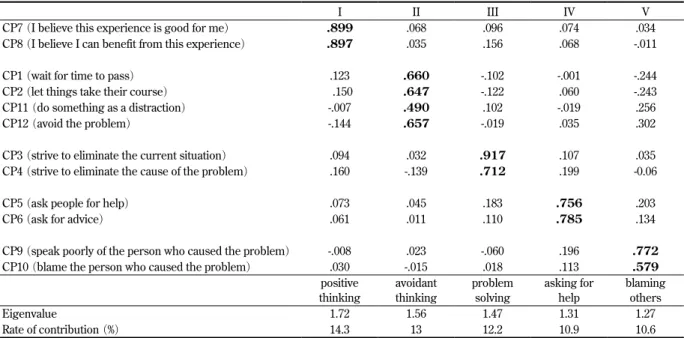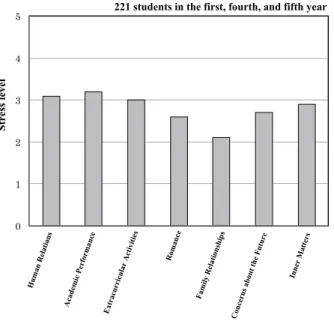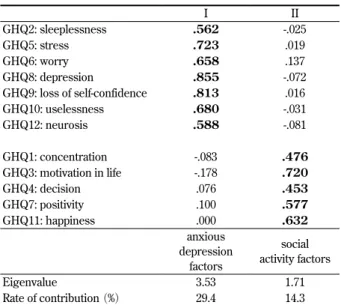Study of the Influence of Life Events and Coping Methods on the Mental Health of Medical Students
Kentaro T ANAKA , Takayuki M UNECHIKA , Yoshimi I SHII, Naoki U CHIDA , Mariko T ANAKA , Erina T AKEUCHI ,
Midori O KUNO , and Ryoji N ISHIMURA
Department of Psychiatry, Faculty of Medicine, Fukuoka University
Abstract
Between December 2006 and June 2007, we conducted a questionnaire survey on the stress level, mental health, and coping methods among a total of 221 students at the School of Medicine, Faculty of Medicine, Fukuoka University, including 96 first-year students, 81 fourth-year students, and 44 fifth-year students. We conducted a statistical analysis on respective items using Hisata’s life experiences scale for university students, the Japanese version of the shortened GHQ (General Health Questionnaire) comprising 12 questions, and Sakata’s coping scale (12 questions) . As a result: 1. it was revealed that the level of mental health of the medical students was lower compared to their self-awareness of their stress level; 2. stress from inner matters, human relations, and academic performance influenced the mental health of the medical students; and 3. it was found that coping by avoidant thinking as well as by asking for help had a negative influence on mental health, while coping by positive thinking worked positively for social activities.
Key words: Medical students, Life events, Mental health, Stress coping
Introduction
In modern society, which is rapidly changing and becoming more complex, people are exposed to much physical and psychosocial stimulation, leading to the manifestation of various forms of maladaptive conditions.
On a global basis, it has been reported that medical students suffer from various stresses in their daily campus and private lives, responsibility and anxiety regarding their futures as medical practitioners, examinations in educational environments such as CBT (Computer Based Test) for evaluation of knowledge and OSCE (Objective Structured Clinical Examination) for evaluation of skills and attitudes regarding consultation, the hurdle of the national examination for medical practitioners after graduation, and the stress involved in having to adjust themselves to these
1)2)3)4). These stresses also include issues such as human relations, along with academic performance and romance, with excessive stress potentially leading to
physical and mental problems, lower self-evaluation of the students, and also influencing their learning ability and academic work. Students carry out various methods of coping with these stresses (coping strategies) to maintain physical and mental health. Recently, the relationship between stress and health in medical students has been attracting a great deal of attention, with some studies revealing that stress in academic work and the lives of medical students influences individual mental and physical condition
5)6). Moreover, correct evaluations of stress related to medical education are being made
7).
We hereby repor t on our investigation into the relationship between stressful life events and coping in medical students at Fukuoka University, with the addition of a discussion.
Subjects and Methods
Between December 2006 and June 2007, we conducted a questionnaire survey among a total of 221 students at
Correspondence to: Kentaro TANAKA, MD, PhD Department of Psychiatry, Faculty of Medicine, Fukuoka University,7-45-1 Nanakuma, Jonan-ku, Fukuoka 814-0180, JAPAN
Tel: +81-92-801-1011 Fax: +81-92-863-3150 E-mail: kentanaka@adm.fukuoka-u.ac.jp
the School of Medicine, Faculty of Medicine, Fukuoka University, including 96 first-year students (66 male and 30 female) , 81 fourth-year students (49 male and 32 female) , and 44 fifth-year students (28 male and 16 female) . The actual survey was conducted during school hours for the first and fourth-year students, and during the period of psychiatric clinical training for the fifth-year students. The following questionnaire was used for the survey.
1. Hisata’s life experiences scale for university students
From 9 life fields according to Hisata’s life experiences scale for university students
8), 7 life fields with a certain degree of impact that medical students may experience
(human relations, academic performance, extracurricular activities, romance, family relationships, concerns about the future, and personal inner world) were selected, and each item was evaluated on a scale of 1 to 5. We investigated how much the students felt stress in the abovementioned 7 life fields over the past month. 1 point was given for “no stress”
and 5 points were given for “complete stress,” indicating that higher scores reflected higher stress levels.
2. Japanese version of the shortened GHQ (General Health Questionnaire) comprising 12 questions GHQ was developed by Goldberg from England as a screening test for nonorganic and nonpsychotic mental disorders and was selected by the WHO as the most appropriate screening test for neuropsychiatric disorders.
It was introduced to Japan in 1985. GHQ, in addition to the 60-question version, includes four shortened versions, a 30-question version, a 28-question version, a 20-question version, and a 12-question version, which were created by selecting items from the 60-question version which are highly capable of distinguishing mental disorders. The usefulness of the shortened versions has been indicated by Fukunishi
9). We herein used the 12-question version in order to reduce burden on the subjects.
Because GHQ is commonly used as the scale of mental health in studies with healthy subjects, GHQ was used as the scale of mental health in this study. The GHQ scoring method was used for evaluation, with 0-0-1-1 points given to the choices in series and calculated as scores.
3. Sakata’s coping scale (12 questions)
As a coping scale, Sakata’s scale (1989)
10)was partly modified and used. This test consists of 12 questions, and for the events answered in Hisata’s life experiences scale
for university students, each item was rated on a scale of 1 to 3 under the teaching of “how to cope with the events.” 0 was given to “not used at all” while 3 points were given to
“used very often,” indicating that higher scores reflected a higher frequency of using a coping method.
It should be noted, GHQ and coping, was subjected to factor analysis. The factor analysis, based on the correlation matrix between a number of variables, is an analysis method of extracting latent factors that define their relationships. The strength and direction of the relationship between the extracted factors and the variables is represented as the factor loadings. In any factor, some slight number of variable groups, showed a strong correlation (factor loadings), it is possible to know which factor is representative of any variable group. Based on these correlations (factor loadings) the representative meaning of a factor, is read out and a suitable agent name is added. Factor analysis is a statistical technique to combine a number of related independent variables into a small number of “factors”.
For the scoring of GHQ and coping, the measure score of the factor is obtained by dividing the sum of raw scores of strongly correlated (high factor loadings) question groups in every extracted factor by the number of questions.
Results
1. The stress level in university life events
Fig. 1 shows the stress level of each life event in 7 life fields. As seen in the figure, it appears that the level is higher in academic performance and human relations than other items but the average was approximately 3 points, which is the “neither low nor high” level, and the stress level of the medical students was not high.
2. The total score of GHQ
The total score of GHQ is 5.03 points. A cut-off value is 4 points, indicating that the level of mental health of the medical students at Faculty of Medicine, Fukuoka University is low.
3. Analysis of coping factors
It has been commonly discussed in previous studies that
types of coping are divided into active coping and passive
coping. Therefore, we conducted an analysis of coping
factors in order to learn the structure of stress coping
in medical students. Regarding the factor analysis, once
factors were extracted using the principal factor method,
Table 1. Factor loading of the coping scale
I II III IV V
CP7 (I believe this experience is good for me) .899 .068 .096 .074 .034 CP8 (I believe I can benefit from this experience) .897 .035 .156 .068 -.011 CP1 (wait for time to pass) .123 .660 -.102 -.001 -.244 CP2 (let things take their course) .150 .647 -.122 .060 -.243
CP11 (do something as a distraction) -.007 .490 .102 -.019 .256
CP12 (avoid the problem) -.144 .657 -.019 .035 .302
CP3 (strive to eliminate the current situation) .094 .032 .917 .107 .035 CP4 (strive to eliminate the cause of the problem) .160 -.139 .712 .199 -0.06 CP5 (ask people for help) .073 .045 .183 .756 .203 CP6 (ask for advice) .061 .011 .110 .785 .134 CP9 (speak poorly of the person who caused the problem) -.008 .023 -.060 .196 .772
CP10 (blame the person who caused the problem) .030 -.015 .018 .113 .579
positive
thinking avoidant
thinking problem
solving asking for
help blaming
others
Eigenvalue 1.72 1.56 1.47 1.31 1.27
Rate of contribution (%) 14.3 13 12.2 10.9 10.6
Numbers in bold in Table1 represent 0.450 of factor loadings or more.
Questions 7 and 8 of coping, having a strong correlation to factor Ⅰ (high factor loadings) , are grouped in one, and taking into account the contents of the questions, factor Ⅰ is named “positive thinking”.
Questions 1, 2, 11 and 12 of coping, having a strong correlation (high factor loadings) to factor Ⅱ, are combined into one. Taking into account the contents of the questions, factor Ⅱ is named “avoidant thinking”.
Questions 3 and 4 of coping, having a strong correlation (high factor loadings) to factorⅢ , are put together in one group. Taking into account the contents of the questions, factor Ⅲ is named “problem solving”.
Questions 5 and 6 of coping, having a strong correlation (high factor loadings) to factorⅣ, are grouped in one. Taking into account the contents of the questions, factor Ⅳ is named “asking for help”.
Questions 9 and 10 of coping, having a strong correlation (high factor loadings) to factor Ⅴ, are compiled in one. Taking into account the contents of the questions, factor Ⅴ is named “blaming others”.
factor rotation was performed by varimax rotation. Taking the eigenvalue for each factor into consideration, a 5-factor solution was finally employed. The factor loading of the coping scale is shown in Table 1. The rate of variance contribution (eigenvalue) was 14.3% (1.72) , 13.0% (1.56) , 12.2% (1.47) , 10.9% (1.31) , and 10.6% (1.27) , for the first factor, second factor, third factor, fourth factor, and fifth factor, respectively, while the cumulative percentage of these variance contribution rates was 61.0%. The items were selected on the basis of factor loading of 0.450.
Regarding the first factor, the coping (hereinafter CP)
items, CP7 (I believe this experience is good for me)
and CP8 (I believe I can benefit from this experience)
indicated high factor loading, so the first factor was named
“positive thinking” according to the previous study by Nishimura
6). Regarding the second factor, the items CP1
(wait for time to pass) , CP2 (let things take their course) , CP11 (do something as a distraction) , and CP12 (avoid the problem) indicated high factor loading, so the second factor was named “avoidant thinking” according to the
previous study. Regarding the third factor, the items CP3
(strive to eliminate the current situation) and CP4 (strive to eliminate the cause of the problem) indicated high factor loading, so the third factor was named “problem solving” according to the previous study. Regarding the fourth factor, the items CP5 (ask people for help) and CP6 (ask for advice) indicated high factor loading, so the fourth factor was named “asking for help” according to the previous study. Regarding the fifth factor, the items CP9 (speak poorly of the person who caused the problem)
and CP10 (blame the person who caused the problem)
indicated high factor loading, so the fifth factor was named
“blaming others” according to the previous study. These coping factors are similar to the survey by Folkman et al.
11)in content and appear to be factors that are reliably extracted.
Next, with these 5 factors as a subscale, the rough point
total of the group of items shown in Table 1 was obtained,
which was subsequently divided by the number of items to
obtain the scale score.
0 1 2 3 4 5
1 1 4 5
Stress level
221 students in the first, fourth, and fifth year
Stress le ve l
Hum an Relations
Academic Performance Extracurricular Activities
Romance
Family Relationships Concerns about the Future
Inner M atters
0 0.5 1 1.5 2 2.5 3
Coping score
Positive
Avoidant
Problem solving
Asking for help
Blaming others


